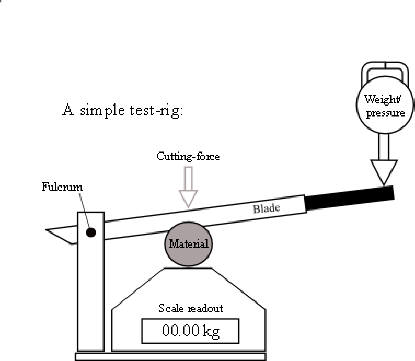
They can cut it - why can’t I?
Have you often wondered why you seem to have difficulty cutting your mats - while others seem do so with incredible ease? Well, it all has to do with skill; having the right sword and right and properly prepared cutting-mats.
Here are some comparisons between the most commonly available mats available in Sydney, Australia:
The tameshigiri-standard: Japanese old/used Tatami-omote versus green/new Tatami-omote and Chinese beach-mats.
What we wanted to find out was how these mats compared to each other when cut either dry; wet; and boiled: the results were quite surprising.
Results, when doing your own testing , may not be the same but - we are sure - very similar.

We build a simple test-rig that would tell us how much pressure in grams or kg was needed to cut through samples of single strands and rolled up mats. We would cut each sample ten-times - get the average - and compare the results.
Each strand was cut 3 times at various length and thickness, thus givingus a good idea of each mat-type’s resistance and how they compared to each other: using the old tatami-omote as a guideline marked 100%.


Cutting-test of wet/damp mats
(fully soaked and drip-dried)
:
To make things easier we rolled the samples at 20 mm diameter and cut them on our test-rig 10-times: after averaging the numbers
we got these results:


Cutting-test of boiled mats
(boiled for 30min and drip-dried)
:
Oh, yes! Sometimes mats are specially treated (boiled) to make them softer and easier to cut; especially when cutting big volume targets at demos!
Tested same as wet mats:


Japanese tatami-omote (old/used) are the ones used in Japan for all tameshigiri.
They are discarded regularly by households and can be picked up easily for free: only available in Australia when brought in by visiting Japanese sensei.
Comparison between damp and boiled:

Tatami-omote(green/new).
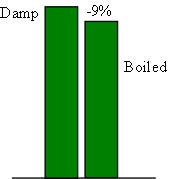
Beach-mats.

The old tatami-omote would, surprisingly, soften by 31%, while the green tatami only softened a mere 9% .The big surprise: the beach-mats just stayed the same.
Having collected all this data we then asked ourselves, “What useful information has it given us?”. As Soul said to his Gangster- friends, “Oils ain’t oils”, so we could now say, “Mats ain’t mats” which isn't much of a result after all that hard work. So we set up another little test-rig, and got some better results outright. And - would we have done this test right first time - we would have saved ourselves a lot of time and hassles.
Comparison cutting-test on fully rolled - wet (drip-dried) mats.
Next we made up an other test-rig that, this time, allowed us to cut into the target-mats from a predetermined height with a constant weight; pulling the blade down into the target; similar to suemono-giri: at the same time recording the mats diameter and weight (wet/drip-dried).
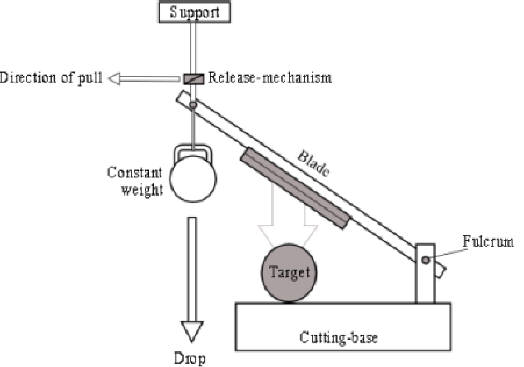
Our second test-rig:
The next illustrations shows how deep and wide the blade cut into each target at a 90 degree angle:
A– 1 rolled Tatami-omote (old/used): 8.0 cm diameter -wet (drip-dry) weight: 2836 gr.
B– 1 rolled Tatami-omote (new/green): 8.0 cm diameter –wet (drip-dry) weight: 2854 gr
C– 2 rolled beach-mats: 7.8 cm diameter –wet (drip-dry) weight: 1320 gr.
No weight-assist (weight of blade only):
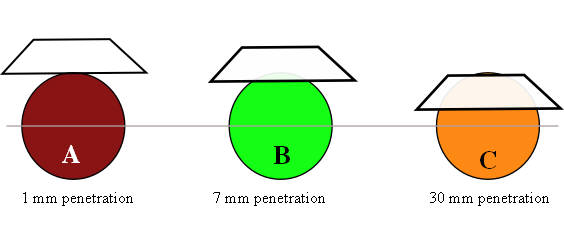
Weight assist (weight + weight of blade)

First we randomly selected 20 single dry strands from each mat and cut them by recording the pressure (grams) used to force the cutting edge through each single strand.
With all the results and variables associated with those tests, it gave us a much better comparison. The most inconsitent item would be the beach-mat: its quality changing with each shipment received! Years ago one would buy beach-mats that were strong and had volume; now they seem to get thinner with each order.
Our testing was done to proof to ourselves what has been buggin' us for a long time - that two rolled up beach mats don't equal one hard tatami-omote - and that green tatami-omote are softer and easier to cut than the old tatami-omote as used in Japan!
Our personal conclusion:
To get a near similar cutting experience from all three mat types - they would need to be cut at an approx. ratio of : 1 rolled damp tatami-omote(old/used) to 1.7 rolled damp tatami-omote (green/new) to 4.24 rolled damp local beach-mats.
After having taken into account the data collected, and the actually “feel” one gets when doing tameshigiri we think the illustration below gives a fair idea how the materials compare to each other.
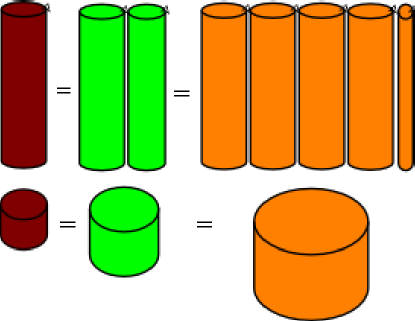

Copyright (C) 2012 SSJS & Sei Do Kan

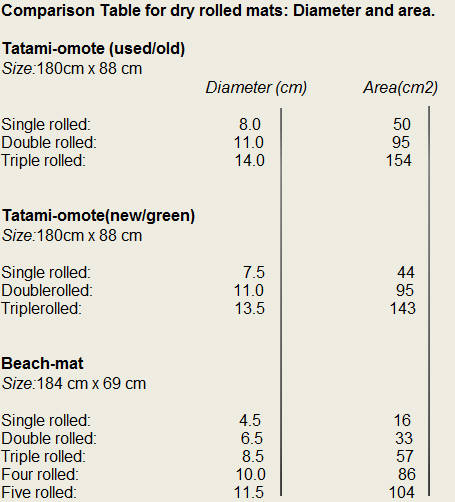
© 2009 - SSJS, Sei Do Kan All rights reserved.